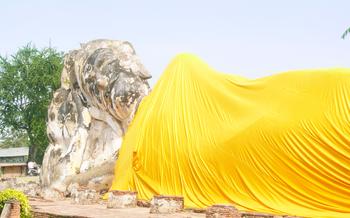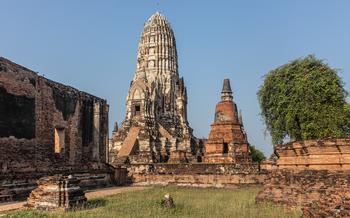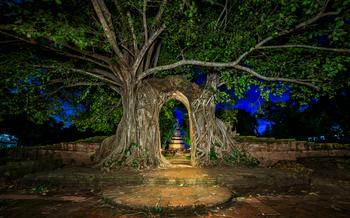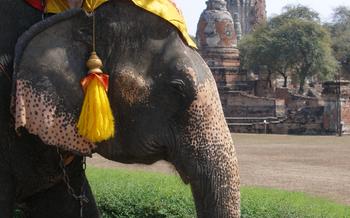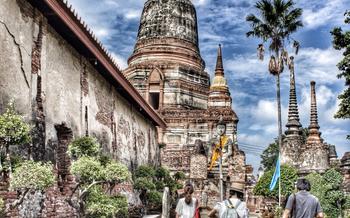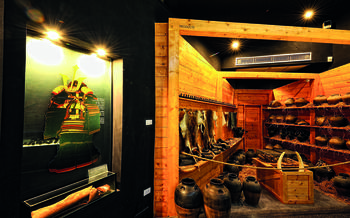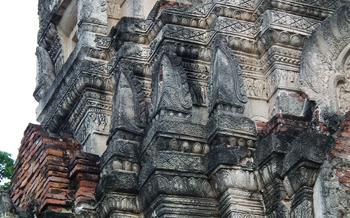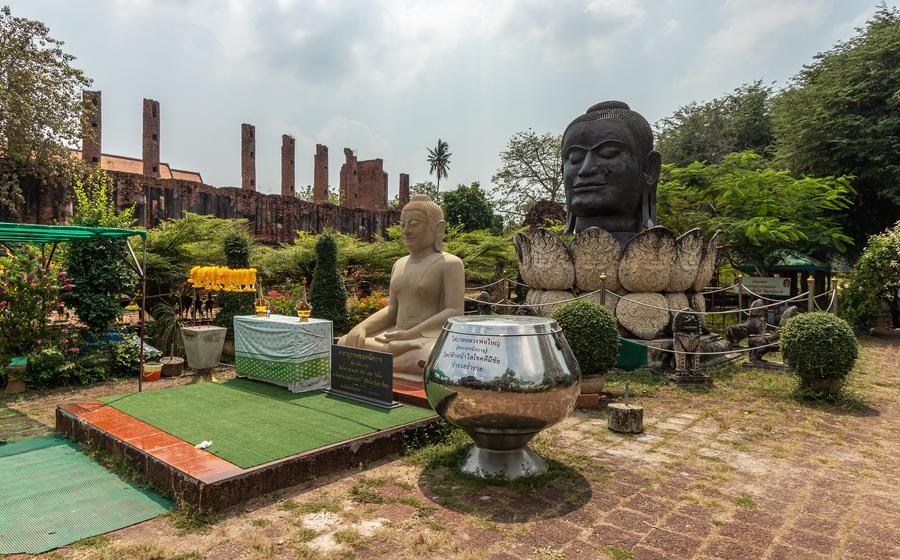
Wat Thammikarat
- Exploring the Temple Grounds
- Exploring the Surrounding Area
- Dress Code and Etiquette
- Photography and Social Media
- Guided Tours and Local Guides
- Wat Thammikarat Festival and Celebrations
- Budget and Costs:
- Solo Travel and Safety
- Off-the-Beaten-Path Experiences
- History of Ayutthaya and the Temple
- Local Culture and Customs
- Insider Tip: Hidden Gem
Exploring the Temple Grounds
The temple complex of Wat Thammikarat is a beautifully landscaped haven of peace and tranquility. As you step through the gates, you will be greeted by a serene atmosphere that invites contemplation and reflection. The temple's layout is designed to promote a spiritual journey, with various structures arranged in a harmonious manner.
At the heart of the complex lies the ordination hall, also known as the ubosot. This sacred structure is where Buddhist monks undergo ordination ceremonies and other important religious rituals. The hall's interior is adorned with intricate murals depicting scenes from the life of Buddha and significant events in Thai history.
Adjacent to the ordination hall is the viharn, a multipurpose hall used for prayer, meditation, and religious teachings. The viharn is often adorned with stunning Buddha images and elaborate carvings, creating an awe-inspiring atmosphere.
As you wander through the temple grounds, you will encounter numerous statues and stupas, each holding its own significance. The statues, often depicting Buddha or various deities, exude a sense of serenity and spirituality. The stupas, or reliquary mounds, pay homage to important Buddhist figures and symbolize the impermanence of life.
The tranquil atmosphere of Wat Thammikarat is further enhanced by the lush greenery that surrounds the temple. The well-manicured gardens, dotted with colorful flowers and tropical plants, provide a serene backdrop for contemplation and reflection. Whether you are seeking spiritual enlightenment, historical knowledge, or simply a tranquil respite, the temple grounds offer a sanctuary for the mind, body, and soul.
Exploring the Surrounding Area
Beyond the confines of Wat Thammikarat, the surrounding area offers a tapestry of cultural and historical attractions that beckon exploration. Embark on a leisurely stroll to discover nearby temples that exude their own unique charm and architectural splendor. Each temple holds its own tales of devotion, spirituality, and historical significance, inviting visitors to delve deeper into the rich tapestry of Ayutthaya's religious heritage.
For those seeking a taste of local life, the bustling markets and shops in the vicinity of Wat Thammikarat offer a treasure trove of souvenirs and handicrafts. From intricately carved wooden figurines to colorful hand-woven textiles, these markets are a haven for those seeking authentic mementos of their time in Ayutthaya. The friendly vendors are always eager to share stories about their products and the local culture, creating a warm and welcoming atmosphere for visitors.
When hunger strikes, savor the flavors of authentic Thai cuisine at the local restaurants and cafes scattered around the temple. Indulge in the aromatic curries, tangy salads, and delectable noodle dishes that are sure to tantalize your taste buds. These culinary delights offer a glimpse into the rich gastronomic traditions of Thailand and are a feast for both the palate and the soul.
For a truly immersive experience, embark on a boat tour or river cruise that meanders through the tranquil waters surrounding Wat Thammikarat. These boat trips provide a unique perspective of the temple and its serene surroundings. As you glide along the river, admire the lush greenery, spot local fishermen casting their nets, and witness the daily life of the riverside communities. The boat tours also offer opportunities to visit other temples and historical sites along the riverbanks, providing a comprehensive exploration of Ayutthaya's cultural heritage.
Dress Code and Etiquette
When visiting a Buddhist temple like Wat Thammikarat, it's crucial to dress respectfully. Opt for modest clothing that covers your shoulders and knees. Avoid wearing shorts, tank tops, or revealing outfits. Removing your shoes before entering certain areas of the temple is a sign of respect. Look for designated shoe racks or areas where visitors can leave their footwear.
Within the temple grounds, maintain a respectful demeanor. Speak softly and avoid loud conversations.
Photography and Social Media
When visiting Wat Thammikarat, it's important to be mindful of proper etiquette when taking photos and using social media. Respect the privacy of other visitors and monks by avoiding taking photos of them without their permission. Flash photography and the use of tripods should also be avoided, as they can be disruptive to the serene atmosphere of the temple.
When sharing photos and experiences on social media, be respectful of the temple's sanctity. Avoid posting images that depict inappropriate behavior or disrespect toward the temple or its surroundings. Instead, focus on capturing the beauty and significance of the temple, sharing your experiences in a way that promotes cultural understanding and appreciation.
Guided Tours and Local Guides
Enrich your visit to Wat Thammikarat by opting for a guided tour. Knowledgeable guides, fluent in English and other languages, are available to provide in-depth insights into the temple's history, culture, and religious significance. They can unveil the stories behind the murals, statues, and architecture, bringing the temple's rich heritage to life.
Hiring a local guide is an excellent way to gain a deeper understanding of the temple's significance and its role in the community. They can share personal anecdotes and cultural perspectives, offering a unique glimpse into the lives of the monks and local people. By supporting local guides, you contribute to the preservation of the temple and the sustainability of the community.
Wat Thammikarat Festival and Celebrations
Wat Thammikarat comes alive during annual festivals and special events, offering visitors a glimpse into the vibrant traditions and beliefs of the local community. The most significant celebration is the temple's annual festival, held over several days and attracting thousands of devotees and visitors. During this festival, the temple grounds are adorned with colorful decorations, and a series of ceremonies and rituals take place, including processions, chanting, and offerings to the Buddha. Visitors can participate in traditional ceremonies, witness cultural performances, and experience the infectious energy of the festival. These events provide a unique opportunity to immerse oneself in the rich cultural heritage of Ayutthaya and Wat Thammikarat.
Budget and Costs:
Visiting Wat Thammikarat is generally affordable, with minimal entrance fees or admission charges. However, it's advisable to allocate a budget for additional expenses, such as guided tours, transportation, and souvenirs. Guided tours typically range from 300 to 500 baht, providing valuable insights into the temple's history and significance. Transportation costs vary depending on the chosen mode of transport and the distance from your accommodation. Tuk-tuks and taxis are readily available and offer convenient options for getting around.
When planning your visit, consider budgeting for meals and refreshments. There are several local restaurants and cafes in the vicinity of the temple where you can enjoy authentic Thai cuisine. Souvenirs and handicrafts are also available for purchase, allowing you to take home a piece of the temple's charm. Remember that respectful bargaining is acceptable and part of the local culture.
Overall, a visit to Wat Thammikarat offers excellent value for money, not just in terms of the entrance fees but also the cultural and historical significance it holds. The experience of immersing yourself in the temple's serene atmosphere and learning about its heritage is priceless.
Solo Travel and Safety
As a solo traveler, exploring Wat Thammikarat can be a rewarding and enriching experience. Here are some tips to ensure a safe and enjoyable visit:
-
Plan Your Visit: Research the temple's hours of operation, dress code, and any special events or festivals that may be taking place. Plan your visit accordingly to avoid crowds and maximize your time.
-
Stay Alert and Aware: While the temple is generally safe, it's important to remain vigilant and aware of your surroundings. Keep an eye on your belongings and be cautious of pickpockets, especially in crowded areas.
-
Respect Local Customs: Remember to dress appropriately, remove your shoes when entering certain areas, and maintain a respectful demeanor. Be mindful of your actions and avoid causing any offense or disruption to the monks and other visitors.
-
Engage with Locals: Don't hesitate to interact with locals and fellow travelers. Ask questions, share experiences, and learn about the temple's history and significance. Engaging with the local community can enrich your visit and provide unique insights.
-
Join a Guided Tour: If you prefer a more structured experience, consider joining a guided tour. Local guides can provide in-depth knowledge about the temple's history, culture, and traditions, ensuring a deeper understanding and appreciation.
Off-the-Beaten-Path Experiences
Beyond the main attractions, Wat Thammikarat offers hidden gems and secluded spots for those seeking a deeper connection with the temple's tranquility. Explore the lesser-known areas of the complex, where you can find serene corners and peaceful gardens. Discover ancient stupas tucked away amidst lush greenery, and uncover hidden Buddha images enshrined in secluded niches.
For a truly immersive experience, engage in meditation or yoga sessions within the temple grounds. Find a quiet spot beneath a Bodhi tree or in a secluded courtyard, and let the tranquility of the surroundings envelop you. Close your eyes and focus on your breath, allowing the serenity of the temple to wash away your worries and bring inner peace.
History of Ayutthaya and the Temple
Ayutthaya, once the capital of the Ayutthaya Kingdom, holds a significant place in Thailand's history. Wat Thammikarat, nestled within this ancient city, is intertwined with Ayutthaya's rich past. Founded in the 15th century, the temple served as a prominent religious center during the kingdom's golden age. It was a place where royal ceremonies, ordinations, and religious festivals took place, attended by the king and his court.
Throughout its existence, Wat Thammikarat has witnessed historical events that shaped Ayutthaya's destiny. During the tumultuous period of Burmese invasions, the temple, like many others, suffered destruction and neglect. However, it was later restored and rebuilt, reflecting the resilience of Ayutthaya's spirit. Today, Wat Thammikarat stands as a testament to the city's cultural and religious heritage, attracting visitors from around the world who seek to delve into Thailand's fascinating history.
Local Culture and Customs
When visiting Wat Thammikarat and other temples in Thailand, it's essential to be mindful of local customs and traditions. Showing respect for Thai culture enhances your experience and demonstrates your appreciation for the country's heritage.
As you enter the temple grounds, remember to remove your shoes before stepping onto the elevated platforms. This is a sign of respect for the sacred space. When approaching monks or other religious figures, wai, the traditional Thai greeting, with your hands pressed together in a prayer-like gesture.
When inside the temple, maintain a respectful demeanor. Avoid loud talking, laughing, or engaging in disruptive behavior. It's customary to sit or kneel on the floor when inside the ordination hall or viharn and avoid pointing your feet towards Buddha images.
Offerings are a common way to show gratitude at Buddhist temples. You can make offerings of flowers, candles, or incense at designated spots within the temple. If you wish to make a donation to the temple, there will usually be a donation box near the Buddha image.
By understanding and respecting local customs, you contribute to preserving the sacredness of Wat Thammikarat and show your appreciation for Thai culture.
Insider Tip: Hidden Gem
Amidst the bustling crowds of Wat Thammikarat, there lies a hidden gem waiting to be discovered. Venture beyond the main temple structures and explore the lesser-known areas of the complex. As you wander through the serene grounds, you'll stumble upon a secluded spot that offers a breathtaking panorama of the temple and its surroundings. Take a moment to pause and soak in the tranquility, away from the hustle and bustle of the main tourist areas. This hidden gem is the perfect place to find peace, serenity, and a deeper connection with the temple's spiritual essence.

